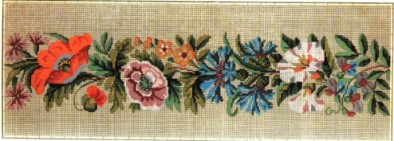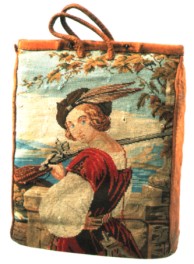
garland of flowers,
Nuernberg, C.Riedel, ar. 1820/40, 31,6 x 11,3cm,
Inv.Nr. 1990.249.2
| ANNE WANNER'S Textiles in History / book reviews, articles |
| Himmlische
Rosen ins irdische Leben embroidery patterns of 19th c. by Margret Ribbert Historic Museum Basle, Switzerland, 2001 |
|
| remarks
by AW: the publication is part of the booklet series of the historic museum Basle. This 12th example has a new size and the content is very attractively represented. All the embroidery designs shown belong to the museum collection and have not been published so far. Most of them were given to the collection between 1995 - 2001. |
| M. Ribbert begins with a short history of the development of the pattern production. Main centre from 1840 to 50 was Berlin with more than 20 publishers, among them the best known A. Philipson and L.W. Wittich. Almost all objects of daily live were decorated with embroidery at that time. Even Goethe wrote on May 15th 1797 to Wilhelm von Humbolt in Berlin whether Humboldt would kindly send him some embroidery patterns with nice colours for a fire screen. |
|
 travelling bag, ar.1840, private possession, Badisches Landesmuseum, Karlsruhe |
|
| Different flowers arranged in bouquets, garlands, wreaths are represented on the single pattern leaves. Botanical accuracy was important, but butterflies and birds also belonged to the motive program. Besides there were reproductions of pictures and with this help large embroideries could be realized. The embroideries adorned pillow covers, bell-pulls, tobacco-pouches, wallets and similar objects. The pattern are not only beautiful to look at they also show the blooming sense of family and friendship of the first half of 19th c., the retreat into the security and cosyness (comfort) of the house and of private live. These embroideries point to the part of women who at that time were patient and endurant, following rules and odds. |
|
| home content | Last revised June 24, 2001 | For further information contact Anne Wanner wanner@datacomm.ch |